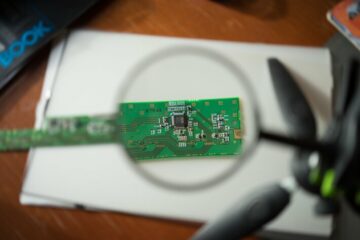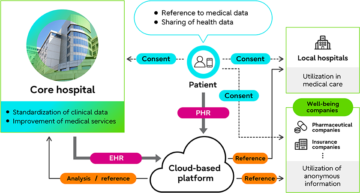As the Internet of Things (IoT) evolves, the volume of data collected from sensors increases exponentially, and processing capabilities must scale to match.
The quantity of data produced by modern IoT systems is phenomenal – IBM states that the average oil rig generates 2TB of data daily from 80,000 sensors, and advanced autonomous cars could generate 40TB an hour.
Building systems that generate vast quantities of data is all well and good, but that data needs to be processed and analysed. Typically, IoT data is fed back to a central cloud or data centre, but this introduces latency bottlenecks that hinder ultra-fast systems. Conversely, edge computing brings processing closer to where data is collected, accelerating processing speeds and lowering system latency.
Edge computing is unlocking new opportunities for processing ultra-high-bandwidth IoT data at ultra-low-latencies. So, what benefits does edge IoT yield? And is now the right time for businesses to invest?
Bringing data processing to the edge


Business investment in edge computing is rocketing, with a predicted CAGR of 37% over the next 5 years. Gartner predicts that around 75% of enterprise data will be processed at the edge by 2025.
So what is edge computing in the context of IoT? In a conventional IoT system, sensors send raw data to a cloud or data centre, which processes the data and sends a response back to the device if required.
This entire process typically takes less than one second, but factors like sluggish internet connections and server response time can impact latency, especially if the data requires complex processing and analysis, e.g., with AI models.
Moreover, internet connections aren’t as reliable as we might like, and high-speed coverage can be patchy. And then, businesses are placing a lot of faith in public cloud providers if they’re handling business-critical IoT data.
Edge computing solves some of these issues by processing data physically closer to where it’s collected, reducing or eliminating the need to process externally.
IoT combined with edge computing is intrinsic to modern low-latency technologies that reliably handle complex data in milliseconds.
How businesses benefit from edge IoT


1: Latency
Edge computing saves time and optimises resources. By time, we’re talking about milliseconds – but if a driverless car is hurtling towards a cyclist at 60mph, every millisecond counts.
AVs must match (or preferably exceed) our own biological nervous system’s reaction time of approximately 100ms to be safe. In that short period of time, sensors must deliver complex data to decision-making models that return the required outputs to accelerators, steering systems, etc. In such high-risk scenarios requiring split-second decision-making, you can’t rely on server-side processing.
Ultra-low-latency performance is also required for applications in Industry 4.0, such as instantly triggering alerts once sensitive equipment shows signs of imminent failure. Similar applies to other safety alert systems that require ultra-fast processing.
2: Scalability
As businesses equip themselves with more IoT sensors, the load placed on endpoints increases exponentially.
Cloud storage involves consistent, ongoing costs that don’t always scale economically. On the other hand, lightweight edge options such as NVIDIA’s Jetson module, an edge AI device capable of performing 21 trillion operations per second, cost just $500 or so.
While edge computing involves upfront costs, running complex workloads solely on cloud architecture may be more costly in some scenarios.
3: Security
IoT presents security concerns surrounding the collection and transport of sensitive data across vulnerable networks.
While edge computing still depends on servers that are vulnerable to hacking attempts, it benefits from being more localised, which assists with data control and security assurance.
Moreover, edge devices can transform and discard data before it reaches a network, and local processing reduces the quantity of data exchanged wirelessly, lowering the potential for interception.
Additionally, edge devices process IoT data in situ, so they circumvent some of the regulatory complexities of transferring and storing data. For example, BMW uses edge devices to process video data in-situ without risking moving it to the cloud.
Combining IoT and edge devices


IoT platforms like PTC ThingWorx, Microsoft Azure IoT, Hitachi Lumada, and Software AG’s Cumulocity have already rolled out edge services and solutions to customers and clients.
Businesses should determine what IoT workloads are worth augmenting with edge techniques.
There are a few things to consider:
- Location: Edge IoT suits use cases where connectivity is patchy or low latency processing is paramount (or both). For example, a ship or oil rig may lack a reliable connection to a cloud or data centre, necessitating processing at the edge to leverage IoT data for more than just monitoring. An IoT sensor connected to an AI system could optimise technology in-situ on the oil rig.
- Controlling logic locally: Edge IoT enables businesses to control logic close to the technology. For example, an autonomous vehicle needs to make ultra-fast decisions without relying on responses from AI models deployed in the cloud.
- Integration with existing systems: Edge computing can slot into existing IoT infrastructure. Businesses can prioritise systems most likely to benefit from edge computing and scale up requirements as they realise the benefits.
The ability of edge devices to ‘slot in’ to existing infrastructure – including legacy systems – is proving an advantage for adoption.
It’s relatively straightforward for businesses to test the waters by deploying edge devices to high-priority applications, measure the benefits, and tweak them accordingly. Edge IoT solves many problems associated with processing large quantities of complex data and using it to garner insights or make decisions at low latency.
With edge-enabled IoT, businesses can create ultra-fast systems sensitive to the millisecond while solving security and regulatory issues and reducing dependence and load on cloud architecture.
- SEO Powered Content & PR Distribution. Get Amplified Today.
- Platoblockchain. Web3 Metaverse Intelligence. Knowledge Amplified. Access Here.
- Source: https://www.iot-now.com/2023/03/03/128369-should-businesses-move-iot-processing-to-the-edge/
- 000
- a
- ability
- About
- accelerating
- accelerators
- accordingly
- across
- Adoption
- advanced
- ADvantage
- AI
- Alert
- All
- already
- always
- analysis
- and
- applications
- approximately
- architecture
- around
- assists
- associated
- Attempts
- autonomous
- autonomous cars
- autonomous vehicle
- average
- Azure
- back
- before
- behind
- being
- benefit
- benefits
- Bloomberg
- BMW
- bottlenecks
- Brings
- businesses
- capabilities
- capable
- car
- cars
- cases
- central
- centre
- clients
- Close
- closer
- Cloud
- collection
- combined
- complex
- computing
- Concerns
- connected
- connection
- Connections
- Connectivity
- Consider
- consistent
- context
- control
- conventional
- Cost
- Costs
- could
- coverage
- create
- Customers
- daily
- data
- data centre
- data processing
- Decision Making
- decisions
- deliver
- dependence
- depends
- deployed
- deploying
- Determine
- device
- Devices
- Dont
- Driverless
- Edge
- edge computing
- eliminating
- enables
- Enterprise
- Entire
- equipment
- especially
- etc
- Every
- example
- exceed
- existing
- exponentially
- externally
- factors
- Failure
- faith
- Fed
- few
- from
- Gartner
- generate
- generates
- Girl
- good
- hacking
- hand
- handle
- Handling
- high-risk
- hinder
- hitachi
- HTTPS
- IBM
- Impact
- in
- Including
- Increases
- industry
- Infrastructure
- insights
- Internet
- internet of things
- intrinsic
- Introduces
- Invest
- investment
- involves
- iot
- IoT Device
- issues
- IT
- Lack
- large
- Latency
- Legacy
- Leverage
- lightweight
- likely
- load
- local
- locally
- Lot
- Low
- make
- many
- Match
- max-width
- measure
- Microsoft
- Microsoft Azure
- might
- millisecond
- models
- Modern
- module
- monitoring
- more
- most
- move
- moving
- Nasdaq
- Need
- needs
- network
- networks
- New
- next
- Office
- Oil
- ONE
- ongoing
- Operations
- opportunities
- optimise
- Options
- Other
- own
- Paramount
- performance
- performing
- period
- phenomenal
- Physically
- placing
- Platforms
- plato
- Plato Data Intelligence
- PlatoData
- potential
- predicted
- presents
- prioritise
- problems
- process
- processes
- processing
- Produced
- providers
- ptc
- public
- Public cloud
- quantity
- Raw
- raw data
- Reaches
- reaction
- reduces
- reducing
- regulatory
- relatively
- reliable
- rely
- require
- required
- Requirements
- requires
- Resources
- response
- return
- rig
- risking
- Rolled
- running
- safe
- Safety
- Scale
- scenarios
- Second
- security
- sensitive
- sensors
- Servers
- Services
- Short
- should
- Shows
- Signs
- similar
- Sitting
- slot
- sluggish
- So
- Software
- Solutions
- Solves
- Solving
- some
- speeds
- Still
- storage
- straightforward
- such
- suits
- Surrounding
- system
- Systems
- takes
- talking
- techniques
- Technologies
- Technology
- test
- The
- themselves
- things
- time
- to
- towards
- Transferring
- Transform
- transport
- triggering
- Trillion
- typically
- unlocking
- use
- Vast
- vehicle
- Video
- volume
- Vulnerable
- What
- What is
- which
- while
- will
- without
- worth
- Yield
- zephyrnet












